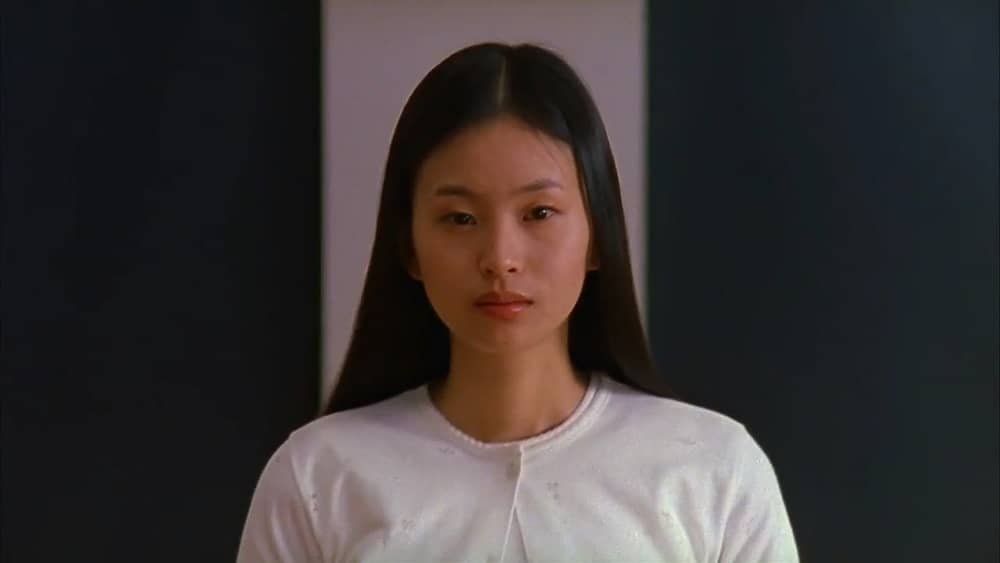‘Audition’ by Takashi Miike, ‘Kaun’ by Ram Gopal Verma and ‘Ek Hasina Thi’ by Sriram Raghavan are the pioneers of introducing a feminist twist in psychological thrillers. In these films the female protagonists are introduced as naïve, innocent and submissive. They pay the price for it until the roles are reversed as the story continues. The dark or grey shade of the main character is revealed as a twist that changes the power dynamics between the oppressor and the oppressed. The cause of their vengeance are revealed as a result of past traumas and betrayals by the oppressor to create a sense of empathy. Here are some common strings in these cults that brings them together.
Color Symbolization

Initially the clothing worn by Asami in Audition, Sarika in Ek Hasina thi and Ma’am (name is not revealed) in Kaun wear white or pastel clothes. White is a symbolization of innocence and purity. Asami continues to wear white clothes from first meet to Aayoma’s dreamy sequences. He gets infatuated from her simplicity and submissiveness on the first meet. He even visualizes her in white clothes in his subconscious state. Asami wears a black dress while torturing Aayoma with acupuncture.
In the one day, one place shot in Kaun , the female protagonist wears plain white dress throughout the day. She is introduced as a woman who gets scared from a thunder of the rain to a clutter in the kitchen. This makes her the least suspected character as a convict who seems to be most vulnerable to any kind of danger. Thus, a plain white dress adds to the fragility of her character. In Ek Hasina Thi Sarika wears simple white and pastel clothes. Thus, signifying her incorruptibility making her a perfect prey for the too good to be Karan. In the last scene, Sarika wearing full black dress after taking her revenge signifies her loss of innocence.
Genre Twist

The first half of Audition appears to be a romantic comedy which turns out be a satire of this cliché genre as we head towards the dark fate of the characters. The slow twist with eerie surreal juxtaposition of Asami in Aayoma’s subconscious mind changes the whole feel good ambience of the first half to a sinister vibe of a psychological thriller.
RGV’s Kaun starts from a horror with the main character getting anxious by even the little sound in her own house (as we perceive in the beginning) to a thriller with the entry of two suspicious characters and a slasher with the final twist. Thus, it is one of the best psychological thrillers of indian cinema. Ek Thi Hassena starts with a slow burner suspense thriller in the first half to a cat and mouse action thriller in the second. Thus, making the revenge fest of Sarika a thrilling ride.
Male Manipulation

Male manipulation is a common link between all these films which signifies a major gender- power dynamic between the oppressed and the oppressor. In Audition , Aayoma with his colleague set up fake job interviews of young girls to find himself a suitable companion. The ignorance of the deceit to lure Asami signifies the huge offence of cheating women for professional jobs and treating them as an object of desire. It is revealed later that Asami was sexually assaulted in her childhood. Therefore, she tends to torture and murder men who reminds of her past abuses.
In Raghuvan’s Ek Hasina Thi , The too good to be true Karan indirectly drops hints throughout the first half thus making the audience suspicious but not Sarika. Even after making her the convict of a crime she is clueless about his truth. He manipulates her to accept the crime and further gaslights by making false promises of rescuing her. In Kaun, Manoj Bajpayee’s eccentric character makes false stories to get inside the house which makes him a suspicious character throughout the film. Sushant singh’s character also pretends to be a cop to get inside the house and later reveals to be a criminal thief. Both the male characters make false promises to win over the trust of the madam as a pass to get inside the house. As the film proceeds more of their lies and deceits of these characters are uncovered which contributes to the major twists and turns in the film.
Underlying Sexism

Audition is a testimony of how heterosexual men perceive women in a patriarchal society majorly focusing the male demography in Japan. Shigehiko (aayoma’s son) is cheered by his father as he brings a girl home signifying the women’s mere objectification to be treated as trophies and achievements in cliche commercial romcoms. The prevelance of male gaze directs the atrocities of female objectification in Japanese society. Aayoma is a middle aged widower with a teenage son who seeks a romantic partner in young women. Although he is made to seem like a modest man but he gets infatuated by Asami in first glance in the staged audition without knowing her. Thus, there is a significance of women’s beauty and men being visual creature. Asami is an ideal woman as per Aayoma’s standards. She seems obedient and naïve. He somewhat overlooks her years of pain and misery which he is taught to feel in the final act of torture.
In Kaun, the madam is being underestimated by both the male protagonists who are manipulating her faith in them and audience too get busy in guessing the real murderer between the 2 strange intruders. In Ek Hasina Thi, the very suave, rich and charming Karan turns out to having a connection with the underworld. He finds a prey in Sarika who is submissive. Sarika symbolises agreeable women who have to shield themselves with assertiveness in order to survive in the world. Sarika symbolizes innocence, Kabir symbolizes crime and after the deceit she becomes a completey different person which signifies the loss of innocence.
Female Vengeance

In Addition, the constant sexual abuse of Asami by his stepfather created a sense of hatred for men who reminded her of past mistreatments. Her way of revenge was brutally torturous. She uses acupuncture needles and piano thread to torture Aayoma. His constant ignorance of understanding her as a person ignited the fire again inside her. Through the subconscious flashbacks with Asami seating bleakingly in a room of filled plastic garbage indicates she has been seeking revenge from all the men in her life who didn’t treated her right.
In Ek Hasina Thi, after experiencing so many setbacks in jail when she comes in terms about the truth of Karan she rises from her ashes like a phoenix. As Karan turns out to have a connection with the underworld who frames Sarika as a convict for keeping his arms. He further gaslights her to accept the crime and gives false hope to rescue her. Instead of just crying about the deception she chooses to take revenge for herself without sparing any mercy on the people involved in this international racket. In Kaun, the madam’s past is not revealed neither her background. RGV metaphorically avenges every naïve female character in cinema who is underestimated and manipulated by the male characters in the form of a surprising twist in the climax.
Insanity

In Audition, Takashi Miike’s justifies Asami’s insanity due to years of assault and torture by her stepfather in her childhood. The years of trauma affected her as an adult as our childhood makes or breaks us. According to ‘Attachment theory’ the young child need to have a compassionate relationship with atleast one primary caregiver for normal and emotional development. Thus, the lack of it can make someone more likely to be a sociopath in their adult life. In Asami’s case she didn’t had any genuine well-wisher in life. She spent years being isolated in her apartment.
In Kaun, neither madam’s background is revealed nor her cause of insanity leaving it to the audience to make several assumptions about the character. In the climax it is revealed that the madam is the serial killer who is out as displayed in the TV and she is just another intruder in the house like the eccentric salesman and the thief. Unlike Kaun and Audition, where the characters are already revealed to be a sociopath Sarika gets a character development. Due to the huge betrayal she transforms from a naïve girl to a bold and fierce woman out for her revenge. She is not literally a sociopath but chasing and killing people by taking law in her own hand needs insanity.
Change of Power Dynamics

In Audition, Aayoma is evidently in the position of power as he conducts the staged interview and select the suitable girl for himself. Although there is a consent in part of Asami but she is treated as an object of desire throughout the film. Asami takes over the control by hallucinating Aayoma and slowly torturing him at the end for not seeing him as a person. It can be assumed that Asami has been playing this game of giving the power to men and then taking it away if they fault for a long time.
In Kaun, initially the scared madam seems to be the victim who is being manipulated by two intruders. She seems to be vulnerable to loud noises, the big mansion and all the possible threats inside as well as outside the house. But, as she comes out as the sociopath killer who has been residing in the house and probably even killed the owner of the house there is an ultimate shift of power. She becomes terrorizer whereas the whole time suspicious salesman runs for his life. In Ek Hasina Thi, Karan sees a perfect prey in Sarika. He conspires a big trap over Sarika and she falls in it. But, she chooses to rise from it get her justice by hook or by crook. She becomes the predator and Karan becomes the prey. Thus, the character development of Sarika contributes to the change of power dynamic of the characters.
Allegory

In Ek Hasina Thi, rats are the symbolization of fear and weakness for Sarika. Her phobia of rats is initially mocked by Karan when she spots one in her kitchen. In Jail, when she finds a rat she confronts her fear and overcomes it. This signifies the birth of a whole new person who is fierce and bold. In the end, as a revenge torture when Karan is put in a cave he is terrorized by a cluster of rats attacking him. Raghavan displays the irony of a newfound fear for Karan that is death. The film ends with the rats feeding over his dead body, he could not get over his fear unlike Sarika. Ram gopal verma’s Kaun left many unresolved mysteries to audience assumptions.
Apart from the three main characters, the house, the telephone, and the cat plays another characters signifying the mental disorder of madam. The madam gets scared of the spirits whom she has already killed. Her background or her past is not revealed but she has been living in someone’s house named dr. Malhotra who she too murdered. The cat was with her all the time but gets murdered when the eccentric intruder enters the mansion. We can assume the murderer could be either of them as the intruder revealed his repulsion of cats soon after which it gets killed. The phone she has been using all this time turns out to be wireless which hints towards her mental disorder. RGV efficiently utilizes all the props in the house from the metal armor, to the doorhole, and the stairs contributing to the story. In Audition pain is a motif that the protagonist endured in all her childhood and she transfers it to her companions who breaks her trust. Miike created a depth in Asami’s character that Aayoma tend to disregard as he has not gone through the similar experience and he is more infatuated to her looks . Asami tends to make him feel her pain by similarly torturing him. His step father used to burn her with sticks , she uses similar kind of tortures when she finds out Aayoma has been married once and has a teen son.

